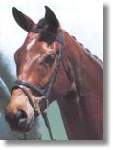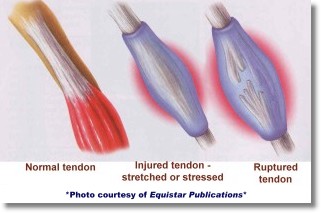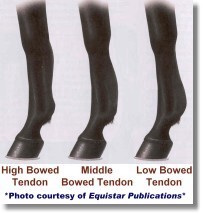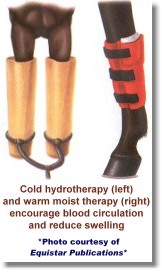
Dublin Lined Event Bridle with Flash Noseband
$59.95
| |
|
What Can You Do About Bowed Tendons? (Part I)
|
Common among racehorses, hunters, jumpers, and even Quarter horses, a bowed tendon can be a long-healing and sometimes permanent threat to the horse’s performance.
The tendon is a thick and relatively inelastic band of fibers that connects muscle to bone. There are three tendons involved in the flexion and extension of the leg. The common digital extensor, located along the front of the leg, straightens the leg while also extending the fetlock, pastern, and coffin joints. In the hind limb, it also flexes the hock joint. The superficial digital flexor and the deep digital flexor lay along the back of the leg, with the deep digital routed beneath the superficial. These two work together in conjunction to flex the knee and all the joints below, while also straightening the hock joint.
There are additional components that help protect the tendon and assist in the movement of the leg, including:- the “check” ligaments help hold the tendon in place and keep it from overstretching;
- the tendon sheath surrounds the tendon at specific points, strengthening it and permitting a gliding motion;
- the paratenon is loose tissue that fills between the tendon sheath and the tendon, and assists in the gliding motion.
 Tendinitis or bowed tendon occurs when the tendon has been strained or stretched beyond its normal tolerance. It can be so overstretched that it tears or ruptures. Bowed tendons are often not the result of one misstep, but rather a series of missteps on a loaded limb where damage has already occurred in a minimal form, but gone undetected. Then, the “last” misstep results in the more serious injury. Several factors can cause this injury, including: Tendinitis or bowed tendon occurs when the tendon has been strained or stretched beyond its normal tolerance. It can be so overstretched that it tears or ruptures. Bowed tendons are often not the result of one misstep, but rather a series of missteps on a loaded limb where damage has already occurred in a minimal form, but gone undetected. Then, the “last” misstep results in the more serious injury. Several factors can cause this injury, including:- Muscle fatigue resulting from inadequate training or conditioning
- Poor conformation (e.g., loading of limb resulting from top heavy conformation, unusual angulation of fetlock, or long, weak pasterns)
- Poor footing, that may be uneven, slippery, or muddy, causing uneven or excessive loading on one limb
- Long toes or improper shoeing, which places extra stress on tendon
- Tight-fitting bandages
Once the injury occurs, it can be so slight as to not even be noticeable or clinically detectable, or it can be so severe that the horse immediately pulls up lame and resists putting his heel down. In a severe strain or tear, the affected limb shows swelling when palpated along with heat and tenderness. Ultrasound often helps to detect the extent of the injury.
 There are three main types of bowed tendons, identified by the location of the “bow” itself. A high bow is situated in the upper third of the cannon just below the knee, while a middle bow, the most common, is located mid-point of the cannon between the knee and the fetlock. A low bow is on the lower third of the cannon bone. If the low bow is positioned in the back of and below the fetlock joint, it may be referred to as a low-low bow. The bow is formed by the scar tissue that results from the swelling, fluid build-up, and fibrous re-growth as the tendon repairs itself. There are three main types of bowed tendons, identified by the location of the “bow” itself. A high bow is situated in the upper third of the cannon just below the knee, while a middle bow, the most common, is located mid-point of the cannon between the knee and the fetlock. A low bow is on the lower third of the cannon bone. If the low bow is positioned in the back of and below the fetlock joint, it may be referred to as a low-low bow. The bow is formed by the scar tissue that results from the swelling, fluid build-up, and fibrous re-growth as the tendon repairs itself.
The heat and swelling occur with the hemorrhaging from the torn tissues, and the release of inflammatory fluids and enzymes. The swelling inhibits the healing process as pockets of blood, serum, and fluids fill up and prevent proper blood flow and circulation. As the tendon tries to repair itself and grow new fibrous tissue, the process is hampered resulting in less elastic re-growth, adhesions, and scar tissue – all of which reduce the strength and elasticity of the healed tendon and increase the risk of re-injury.
Treatment – Conventional
One of the key factors is to treat the injury immediately. Moreover, close attention to slight swelling and heat may mean the difference between a brief lay-up with a strained tendon or a year of rest from a torn or ruptured one. If the injury does occur, emergency treatment should be delivered via cold hydrotherapy, ice packs, and bandaging, all of which are intended to reduce the swelling and allow a strong blood supply to the affected area. The bandages also help in providing support to the weakened limb (one should bandage both limbs – both forelegs or hind legs – to ensure that the horse does not overload the other leg).
If you are away from the barn when the injury occurs, apply a “tourniquet bandage” – one that is wound tightly around the leg – but only for twenty (20) minutes at a time, and then removed for another few minutes before re-applying. Once again, the intent is to reduce swelling and minimize the amount of fluid build-up in the affected limb. It is the enzyme fluid and serum that contributes to the formation of adhesions and scar tissue. Once you return to the stables, begin applying ice and cold hydrotherapy.
Regardless of where or when the injury occurs, contact the veterinarian as quickly as possible in order that he or she may administer anti-inflammatories systemically, such as phenylbutazone or banamine (which will also help with the pain) and/or topically with poultices, DMSO, or capaicin. If ice packs can not be applied throughout the night, the veterinarian may also apply a soft cast or tight bandage to keep the horse’s leg supported and the swelling down through the night. The veterinarian should check the progress the next day, maybe opting to keep the soft cast or tight bandage on for up to a week. After that period, he or she may re-apply this bandaging for another two weeks, depending on the extent of the injury and the healing progress.
 Depending upon the choice of bandaging, the veterinarian may prescribe a physical therapy routine of incorporating massage and warm, moist heat treatment after the initial swelling has gone down. Massage helps to reduce the fluid swelling and the formation of the adhesions and scar tissue. It also helps to orient the new growth of fibrous strands in the tendon. The warm, moist heat will also help to decrease the swelling, stiffness, and pain, as well as increase blood flow and “tissue extensibility.” Depending upon the choice of bandaging, the veterinarian may prescribe a physical therapy routine of incorporating massage and warm, moist heat treatment after the initial swelling has gone down. Massage helps to reduce the fluid swelling and the formation of the adhesions and scar tissue. It also helps to orient the new growth of fibrous strands in the tendon. The warm, moist heat will also help to decrease the swelling, stiffness, and pain, as well as increase blood flow and “tissue extensibility.”
It is important to remember that the recovery and rehabilitation for a horse with a bowed tendon is lengthy. For most, that period can last upwards of one year of rest for a horse’s leg to heal completely. Moreover, the new tissues formed during the healing process are often not as strong or elastic as the “original” ones, thereby making the leg more susceptible to re-injury. For this reason, great care should be taken in returning the horse back to an exercise regime and any future performance.
During the initial phase of treatment, the horse should be kept rested in order that he not aggravate the injury or re-injure the leg. Recognizing the importance of gradually returning the horse to work, Dr. Carol L. Gillis, a veterinarian from the University of California-Davis, has developed a regimen for rehabilitating the horse’s leg. For a mild injury, the horse may be hand walked for fifteen-minute periods twice daily for the first thirty days after the incident. This may be advanced to 40 minutes daily for the next 30 to 60 days. The horse may then be ridden at the walk for 20 to 30 minutes each day for the next 60 to 90 days. A moderate injury requires more hand walking. Instead of being ridden during the 60 to 90 days of rehabilitation, the horse should continue to be hand walked for up to 60 minutes each day. A severely bowed tendon requires hand walking for the entire 90 days, eventually reaching 40-minute periods each day.
Throughout the recovery and rehabilitation process, it is highly recommended that an ultrasound be performed on the leg to evaluate the progress. It is an important tool for diagnosing the problem, revealing the extent of the damage, and for monitoring the injury as it heals. This is especially helpful in ensuring that you are not pushing your horse to fast with his physical therapy and risking re-injury.
In the next installment, MDhorse.com will provide other, and sometimes less conventional, treatments that have been introduced to aid in the recovery from bowed tendons.
Please note that any material on horse health and horse care which has been presented here is offered as general information only and shall not be construed to be professional veterinary advice or care. When dealing with any injury, it is best to contact your veterinarian to establish a treatment that will be most beneficial to your horse.
All pictures have been provided courtesy of Equistar Publications. For more information on their products and services, please visit their web site at www.equistarpub.com.
|
|
|
|
|
|
|



